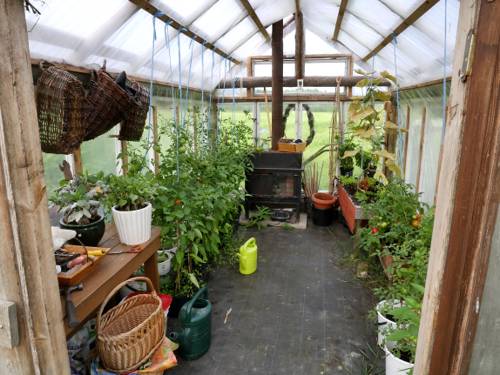
FAQ About Climate-Controlled Indoor Greenhouses

What is a climate-controlled indoor greenhouse?
A climate-controlled indoor greenhouse is a facility designed to simulate optimal growing conditions for various plant species indoors. These greenhouses are equipped with technology that regulates temperature, humidity, and lighting conditions, ensuring a consistent environment year-round regardless of external weather changes.

How does a climate-controlled greenhouse differ from a traditional greenhouse?
While traditional greenhouses rely primarily on sunlight and ambient outdoor conditions, climate-controlled greenhouses use advanced systems to regulate internal conditions such as temperature, humidity, and lighting. This allows for greater control over the growing environment and can support plant growth throughout the year without climatic dependence.

What are the benefits of using a climate-controlled indoor greenhouse?
Climate-controlled indoor greenhouses provide several benefits: they allow for year-round crop production, support a wider variety of plant species regardless of native climate, enhance growth rates through optimal conditions, and protect plants from pests and diseases associated with outdoor environments.

Can you grow any type of plant in a climate-controlled indoor greenhouse?
Yes, climate-controlled indoor greenhouses can support a diverse range of plant species due to their adjustable settings. However, success depends on correctly tailoring environmental conditions to meet the specific needs of each plant type, including temperature, humidity, light intensity, and soil conditions.

What technologies are used to control the climate inside these greenhouses?
Climate-controlled indoor greenhouses utilize technologies such as heating, ventilation, and air conditioning systems (HVAC), automated lighting (including LED setups), humidifiers and dehumidifiers, and sometimes computer-controlled climate management systems that adjust conditions based on real-time data.

How is lighting managed in a climate-controlled indoor greenhouse?
Lighting in climate-controlled indoor greenhouses is typically managed through advanced LED systems that mimic natural sunlight. These systems can be programmed for different light intensities and durations to accommodate the photosynthetic requirements of various plant species, ensuring optimal growth throughout their life cycle.

What are common challenges associated with climate-controlled indoor greenhouses?
Common challenges include controlling energy costs, managing technical complexities of climate systems, ensuring consistent air circulation, preventing mold from high humidity levels, and maintaining balanced nutrient supplies in soil-less growing systems. Proper design and maintenance can mitigate these issues effectively.

How much does it cost to set up a climate-controlled indoor greenhouse?
The cost of setting up a climate-controlled indoor greenhouse can vary significantly based on size, location, and the complexity of the systems installed. Small setups could start around a few thousand dollars, whereas large commercial operations may require investments in the tens of thousands to millions.

How can one optimize energy use in a climate-controlled indoor greenhouse?
Optimizing energy use involves using energy-efficient equipment like LED lights, insulating walls to retain heat, harvesting rainwater for irrigation to reduce costs, employing solar panels, and strategically scheduling climate control operations to reduce energy consumption during off-peak hours.

Can climate-controlled greenhouses help in disaster-prone areas?
Yes, climate-controlled greenhouses can significantly benefit disaster-prone areas by ensuring food security through controlled and consistent crop production regardless of extreme weather conditions outside. They mitigate risks associated with droughts, floods, and other environmental disruptions.

How do climate-controlled greenhouses impact sustainability?
Climate-controlled greenhouses positively impact sustainability by enabling efficient resource use, reducing dependency on international produce, minimizing water consumption through recirculation systems, and potentially decreasing transportation carbon footprints through local production.

What role does automation play in climate-controlled greenhouses?
Automation plays a crucial role in climate-controlled greenhouses, allowing precise control over environmental factors, reducing human error, optimizing operational efficiency, and potentially lowering labor costs. Automated systems can include climate control, irrigation scheduling, and nutrient delivery.

How do you maintain ideal humidity levels in an indoor greenhouse?
Maintaining ideal humidity involves using humidifiers or dehumidifiers as needed, ensuring adequate ventilation, and employing hygrometers to monitor humidity levels continuously. Regular adjustments and system checks are essential to maintain the stability required for plant health.

Can pests and diseases still affect plants in indoor greenhouses?
While indoor greenhouses minimize exposure to outdoor pests and diseases, plants can still be affected. Integrated pest management strategies, regular monitoring, and use of biological control agents can mitigate these risks effectively, ensuring a healthy growing environment.

What types of crops are ideal for climate-controlled indoor greenhouses?
Crops that benefit from climate-controlled indoor greenhouses include high-value plants such as herbs, leafy greens, strawberries, tomatoes, and flowers. These setups are ideal for plants that require specific growing conditions, short maturity cycles, or year-round production.

How important is ventilation in an indoor greenhouse?
Ventilation is critical in indoor greenhouses to provide fresh air, remove excess moisture, and maintain CO2 levels for photosynthesis. Proper ventilation systems help control temperature and humidity and prevent fungal and bacterial growth, contributing to a healthy plant environment.

Is soil required in climate-controlled indoor greenhouses?
Not necessarily. Many climate-controlled indoor greenhouses utilize hydroponics or aquaponics systems, where nutrients are directly delivered to plant roots in water-based solutions. This soil-less approach can optimize growth rates and enhance nutrient uptake efficiency.

How do climate-controlled systems adjust to seasonal changes?
Climate-controlled systems adjust to seasonal changes by recalibrating temperature, humidity, and lighting according to plant needs. These adjustments depend on the data collected through sensors and are often managed by automated systems to ensure the optimal growing environment year-round.

What should I consider when building a climate-controlled indoor greenhouse?
Key considerations include location, size, budget, choice of crops, technology systems for climate control, energy efficiency, and sustainability practices. Understanding local regulations and building codes is also crucial to ensure compliance and successful greenhouse operation.

Do climate-controlled greenhouses require constant monitoring?
Yes, constant monitoring is essential to ensure optimum conditions are maintained. Automated systems can help reduce manual oversight; however, periodic checks and maintenance are necessary to rectify errors, perform calibrations, and facilitate repairs to keep the systems running efficiently.
